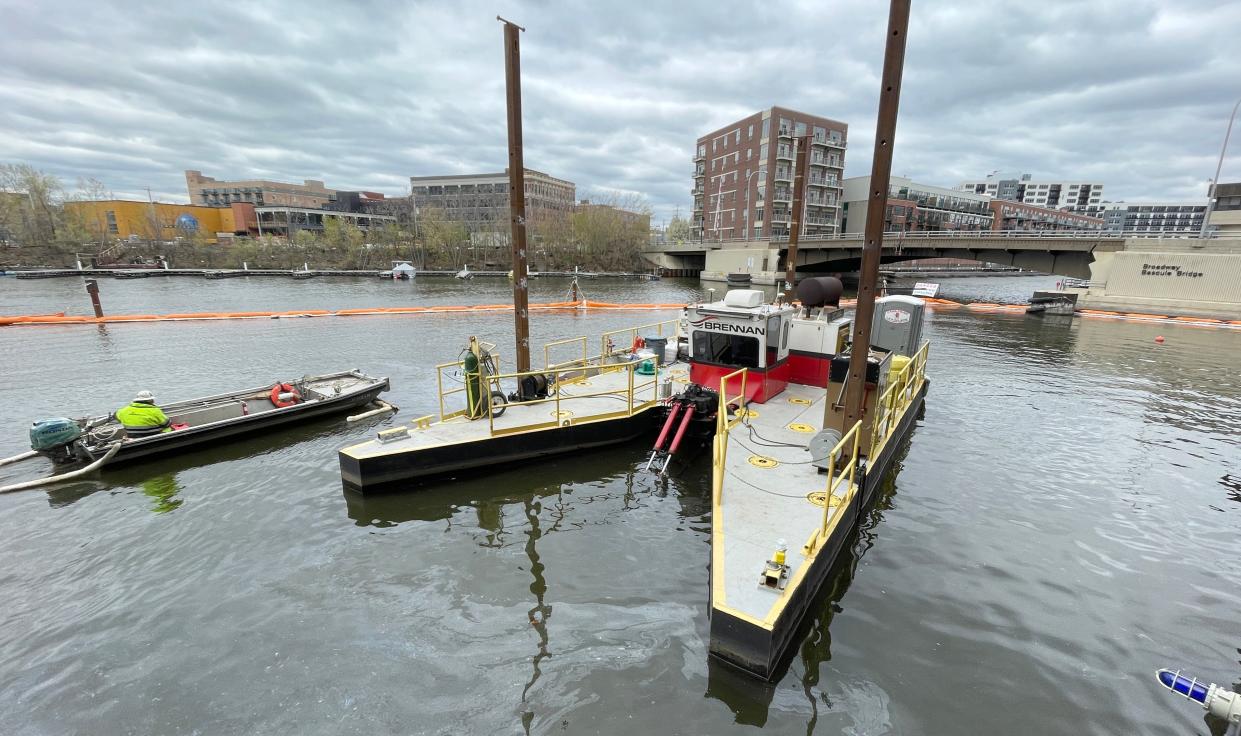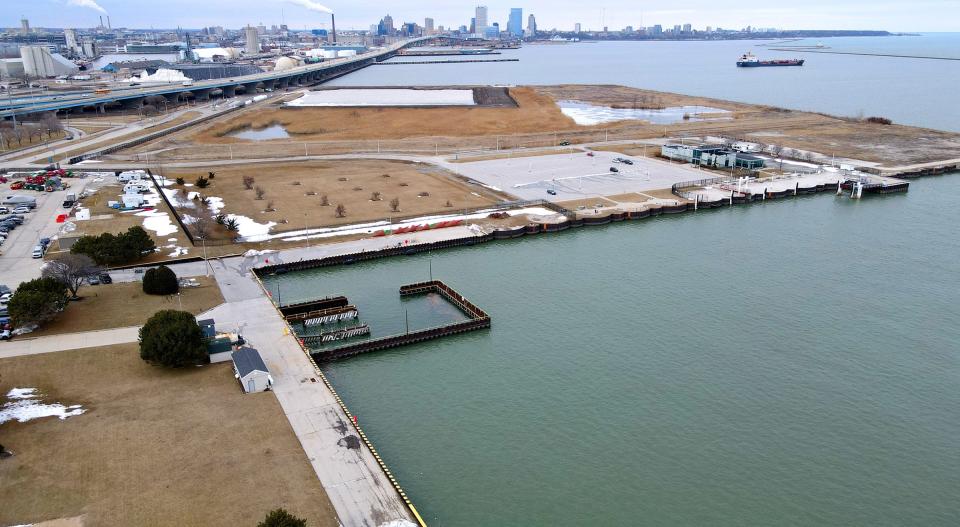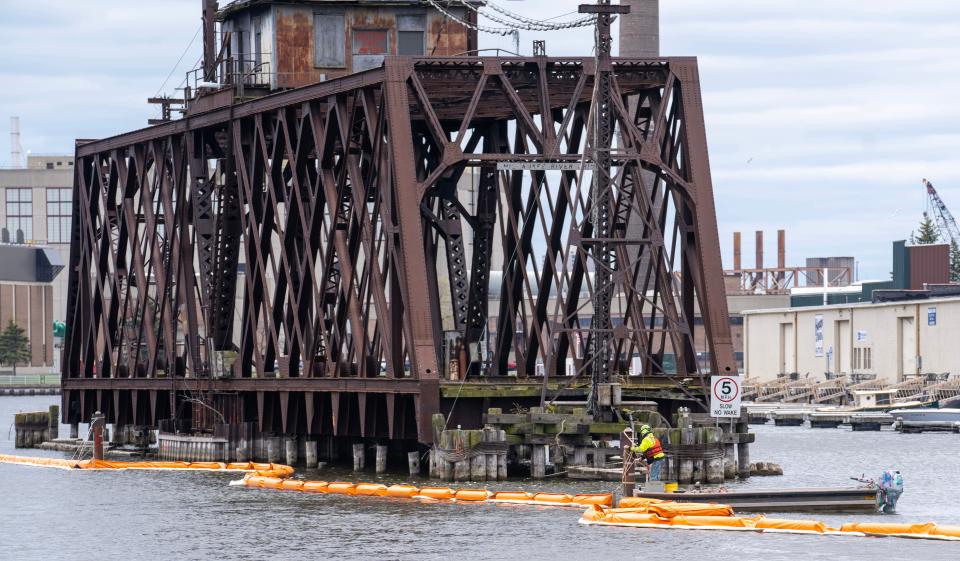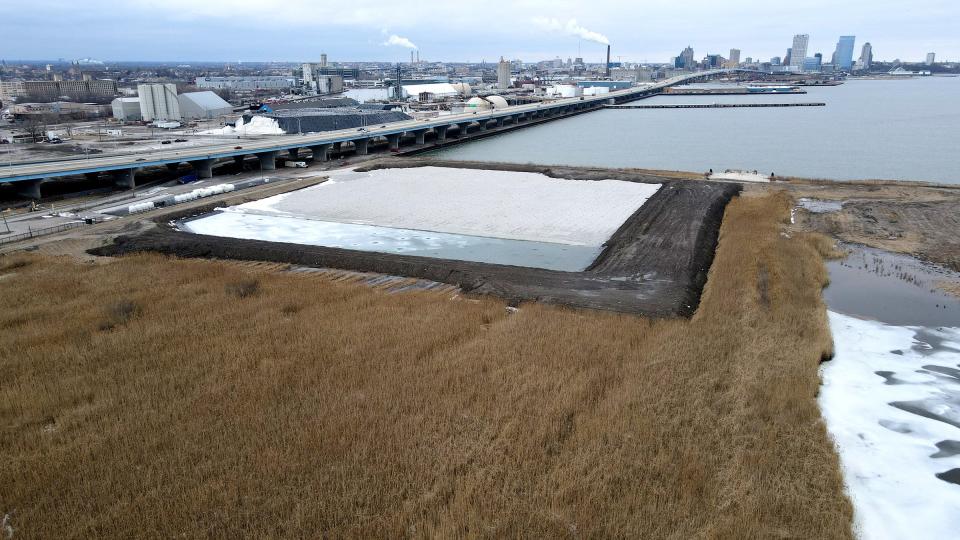Project in Third Ward is removing polluted sediment from Milwaukee River. Here's what's happening.

If you've walked along the Milwaukee River in the Third Ward lately, you may have noticed some action happening in the river.
That's because a new project to remove legacy contamination kicked off at the end of April.
The project to remove polluted sediment is one part of a large-scale effort to clean up the Milwaukee River Estuary, about 12 total miles of waterway that includes the lower reaches of the Milwaukee, Menomonee and Kinnickinnic rivers, and nearshore areas of Lake Michigan. The site is listed as an official "area of concern", one of the most polluted sites around the Great Lakes.
Here's what to know about the project.
What are the Great Lakes' areas of concern?
The U.S. and Canada signed the Great Lakes Water Quality Agreement in 1972, outlining a path to restore and protect the lakes. In 1987, the agreement was updated, identifying 43 areas of concern throughout the entire basin in both countries.
Today, there are 25 sites, including Milwaukee's waterways, remaining on the U.S. side of the Great Lakes. The U.S. Environmental Protection Agency will delist a site once monitoring efforts show that all restoration targets have been met.
What's wrong with the Milwaukee River Estuary?
The Milwaukee Estuary Area of Concern is plagued with 11 "beneficial use impairments" − or symptoms of pollution. Restrictions on fish consumption, beach closings and loss of habitat are some examples of impairments in the Milwaukee River Estuary.
Sediments contaminated with PCBs, or polychlorinated biphenyls, are largely to blame for these impairments. PCBs are a class of more than 200 chemicals that were banned by the federal government in 1979 because they are hazardous to humans, fish and wildlife. The problem is they've settled into the riverbeds and stuck around. They are especially problematic because they are toxic at low levels and can build up in fish and animals higher up in the food web in a process known as bioaccumulation.
Habitat projects are also underway to clean up the waterways for recreation and restore habitat for fish and wildlife. These projects will help improve fish passage, creating more than 30 miles of continuous waterway for fish to travel, reproduce and find food. Fish passageways will be built around the Kletzsch Park Dam and Estabrook Falls both along the Milwaukee River.
The non-federal sponsors on the cleanup efforts include: Milwaukee Metropolitan Sewerage District (MMSD), City of Milwaukee, Milwaukee County Parks, Wisconsin Department of Natural Resources and We Energies.
More: Milwaukee is turning around one of the most degraded sites in the Great Lakes. Here's how.
Where is this work happening?
The dredging project in the Third Ward that kicked off at the end of April is the first river activity. It's led by We Energies.
There are two sites in the Third Ward where dredging is taking place: a small zone west of the North Water Street Bridge, near the confluence of the Milwaukee and Menomonee rivers, and a longer section southeast of the North Young Street Bridge adjacent to East Eerie Street.
About 45,000 cubic yards of sediment will be removed from the two sites, roughly the size of 16 hot air balloons. The polluted sediment is associated with the operation of the former Third Ward Manufactured Gas Plant, which was operated by one of We Energies' corporate predecessors.
The We Energies' project will remove roughly 10 feet of loose sediment, said Patrick Kenny, project manager and environmental consultant at We Energies.
The project will remove about 90% of PCBs along those stretches of the river, he said.
After the polluted sediment is removed, a "cap" will be put down on the riverbed made up of sand, carbon and gravel. The carbon layer soaks up any oily residue left over from the former gas plant.
"This is a once in a lifetime opportunity," Kenny said, noting that while We Energies is often on the "other side" of environmental groups and the EPA, they are coming together for the "greater good" to clean up Milwaukee's waterways.

What will happen with the sediment?
PCB-polluted sediment can't be treated, the sediment can only be physically removed by dredging and then stored permanently in a facility.
The sediment removed from the Third Ward will be pumped through a pipe and stored at the Port of Milwaukee's existing Dredged Management Disposal Facility.
In total, 1.2 million cubic yards of sediment will be removed for the entire area of concern, Kenny said.
MMSD is currently in the process of designing a new facility to accommodate all of the PCB-contaminated sediment.
Will dredging affect foot traffic, recreation, wildlife?
Sections of the River Walk will be closed intermittently near the construction during work hours. The River Walk will reopen on evenings and weekends. It will not affect access to residences or businesses.

The Milwaukee River will continue to be navigable throughout the project, but access to the remediation areas will not be permitted. Access to some private and public docks may also be prohibited. Markers and signs will be placed in the river with information about restricted areas.
According to Kenny, air quality and building vibrations will be monitored while the work is taking place.
Much of the preparation work also took place during the winter, Kenny said, ensuring that there would be minimal disruption to fish, birds and vegetation.
When will the Milwaukee's site be cleaned up?
Sediment removal in the Third Ward should continue through September, Kenny said, but projects throughout the area of concern, like remediating sediment at other sites, restoring fish and wildlife habitat and constructing the new dredged management facility will continue for years to come.
The EPA estimates that the restoration and remediation projects in Milwaukee's area of concern will be competed between 2027 and 2030.

Are there other areas of concern in Wisconsin?
There are three other areas of concern in Wisconsin: the Lower Green Bay and Fox River that flows into Lake Michigan; the Sheboygan River that also flows into Lake Michigan; and the St. Louis River that flows into Lake Superior.
The Lower Fox River and the bay of Green Bay faced similar legacy PCB-contamination from wastewater discharged from nearby paper mills. In 2020, the river was officially declared cleaned up of contaminated sediments after two decades of dredging efforts. The cleanup effort removed 6.5 million cubic yards of contaminated sediment and totaled $1.3 billion dollars paid for entirely by the paper companies.
The EPA delisted Wisconsin's Lower Menominee River in 2020.
Caitlin Looby is a Report for America corps member who writes about the environment and the Great Lakes. Reach her at clooby@gannett.com or follow her on Twitter @caitlooby.
Please consider supporting journalism that informs our democracy with a tax-deductible gift to this reporting effort at jsonline.com/RFA or by check made out to The GroundTruth Project with subject line Report for America Milwaukee Journal Sentinel Campaign. Address: The GroundTruth Project, Lockbox Services, 9450 SW Gemini Dr, PMB 46837, Beaverton, Oregon 97008-7105.
This article originally appeared on Milwaukee Journal Sentinel: PCB cleanup project begins in Milwaukee River. What you need to know.

